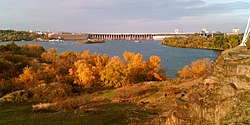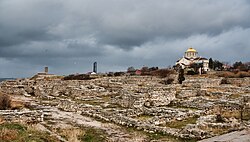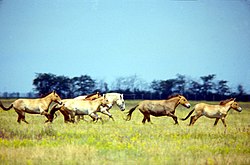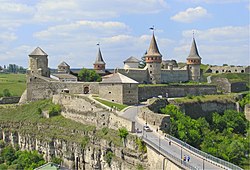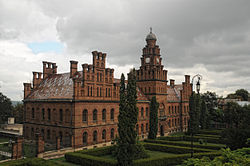Top Qs
Timeline
Chat
Perspective
Seven Wonders of Ukraine
Historical and cultural monuments From Wikipedia, the free encyclopedia
Remove ads
The Seven Wonders of Ukraine (Ukrainian: Сім чудес України, romanized: Sim chudes Ukraïny [ˈsʲim tʃʊˈdɛs ʊkrɐˈjinɪ]) are seven historical and cultural monuments of Ukraine, which were chosen in the Seven Wonders of Ukraine contest held in July, 2007. This was the first public contest of that kind which was followed by the Seven Natural Wonders of Ukraine, the Seven Wonderful Routes of Ukraine, and the Seven Wonderful Castles of Ukraine. All nominated sites are publicly owned protected areas of at least regional level, available for tourism.

The voting for all contests consisted of two parts: experts in Ukraine voted for their seven best sites, and internet users voted for their seven favorite sites on the official website.
Remove ads
History
The initiative was started by (one of the) deputy chairman of Verkhovna Rada Mykola Tomenko under the motto "Piznai Ukrainu!" (Discover Ukraine). The initiative was a continuation of numerous preceding public actions that took place in various regions of Ukraine such as "Kupala's games at the native land of Gogol" (Poltava Oblast), "Starry autumn in Kachanivka" (Chernihiv Oblast), "Let's discover Khortytsia Island" (Zaporizhzhia Oblast), "Masliana in Bukovina" (Chernivtsi Oblast), "Amber legends of Rivne Oblast", "Day of Europe at the native land of Lesya Ukrainka" (Volyn Oblast), and others.
The next stage of the initiative was the organization of the Seven Natural Wonders of Ukraine in 2008.
Remove ads
Organization committee
Summarize
Perspective
This article may contain an excessive amount of intricate detail that may only interest a particular audience. (September 2013) |
The organization committee consisted of:[1]
- Mykola Tomenko (parliamentarian of the 5th convocation of the Ukrainian parliament)
- Andriy Pakhlya (head of State Service of tourism and vacation resorts)
- Oleksandr Volkov (parliamentarian of the 5th convocation of the Ukrainian parliament)
- Oleksandr Bryhynets (Kyiv city politician)
- Yuri Artymenko (deputy head of parliamentary committee)
- Volodymyr Kurinny (head of Vekhovna Rada subcommittee)
- Volodymyr Ilchenko (chief-editor of "Mandry" magazine)
- Oleksandr Bohutsky (general director of Ukrainian TV-channel ICTV)
- Viktor Kolesnyk (dean of historic department of Kyiv University)
- Viktor Nabrusko (president of the National Radio company of Ukraine)
- Ihor Pasichnyk (rector of the National university Ostroh Academy)
- Nataliya Sumska (National actress of Ukraine)
- Anzhelika Rudnytska (Distinguished actress of Ukraine)
- Volodymyr Shevchenko (rector of Donetsk National University)
- Oleksandr Kharchenko (chief-editor of informational agency UNIAN)
Partners
Remove ads
Selection
Local and provincial (oblast) authorities composed a list of 1,000 possible candidates. An expert council consisting of 100 people, including culturologists, historians, and tourist specialists, chose a list of 21 candidates from which people on the internet could vote.
Voting on the 21 possible candidates was opened on July 7, 2007.[2] A total of around 77,000 internet users voted in the campaign.[3] The voting was closed on August 21, 2007 and the results were officially announced on the same day.[4] The campaign was initiated in May 2007 by Mykola Tomenko, a Ukrainian politician and the deputy of the Parliament of Ukraine of the fifth convocation.
Each manager of a winning nomination was awarded a statue of their candidate made out of green marble, matte steel, and gold-mirror acrylic paint.[5]
Results
Summarize
Perspective
Just before the next Independence Day of Ukraine, on 21 August 2007 were announced final results of the voting.[6]
List
Special nominations
Three objects from the nomination list awarded a special recognition:
- the Livadia Palace, a monument of modern history, Livadiysky Palace-Museum,[15] Monument of Architecture;
- the Ostroh Castle, a spiritual monument, part of the Ostroh Regional Museum;
- the Pysanka Museum in Kolomyia, a monument of modern Ukraine, part of National Museum of Hutsul-land and Pokuttia folk-art of Yosafat Kobrynsky.
Full ranking lists
- Ranking by votes of internet-users: 1) Khortytsia, 2) Sofiyivka Park, 3) Kamianets, 4) Kyiv Pechersk Lavra, 5) Khotyn Fortress, 6) Chersoneses Taurica, 7) Livadia Palace, 8) Pysanka Museum, 9) Sophia of Kyiv, 10) Ostroh Castle and the Academy, 11) Odesa Opera Theater, 12) Stone Grave, 13) Palanok Castle, 14) Pochaiv Monastery, 15) Lutsk Castle, 16) Saint Anthony's Caves, 17) House of the State Industry, 18) Olesko Castle, 19) Holy Mountains Monastery, 20) Pereiaslav, 21) Shevchenko Heritage Park
- Ranking by votes of experts: 1) Kyiv Pechersk Lavra, 2) Sophia of Kyiv, 3) Sofiyivka Park, 4) Chersoneses Taurica, 5) Kamianets, 6) Holy Mountains Monastery, 7) Khortytsia, 8) Pochaiv Monastery, 9) Stone Grave, 10) Livadia Palace, 11) Saint Anthony's Caves, 12) Khotyn Fortress, 13) Ostroh Castle and the Academy, 14) Odesa Opera Theater, 15) Olesko Castle, 16) Shevchenko Heritage Park, 17) Pysanka Museum, 18) Palanok Castle, 19) Pereiaslav, 20) Lutsk Castle, 21) House of the State Industry
Remove ads
All contenders
- Kyiv: Kyiv Pechersk Lavra, Sophia of Kyiv, House with Chimaeras;
- Crimea: Livadia Palace, Mount Mithridat, Alupka Palace and Park Heritage Center, Swallow's Nest;
- Vinnytsia Oblast: Nikolay Pirogov Manor, Old Slavic Cave Temple with Busha Relief, Nemyriv Schythian oppidum;
- Volyn Oblast: Lubart's Castle, Volodymyr complex of historic and cultural landmarks, Lesya Ukrainka Museum in Kolodiazhne, Chelm Icon of Virgin Mary;
- Dnipropetrovsk Oblast: Stone Female Sculptures, Ivan Sirko Grave, Novomoskovsk Trinity Cathedral, Nativity of Mary Church, Ukrainian line;
- Donetsk Oblast: Historic and Architectural Reserve in Sviatohirsk;
- Zhytomyr Oblast: Saint Basil the Great Church, Stone Village, Korolyov Museum of Astronautics;
- Zakarpattia Oblast: Palanok Castle, Forest and rafting museum at Chorna River, Saint Michael Orthodox Church, Nevytske Castle;
- Zaporizhzhia Oblast: Historic and Archaeological Reserve "Stone Grave", Khortytsia, DnieperHES;
- Ivano-Frankivsk Oblast: Pysanka Museum, Dovbush Rocks, Holy Spirit Church;
- Kyiv Oblast: Pereiaslav Historic and Ethnographic Reserve, Liutizh Beachhead, Ivan Kozlovsky Manor, Arboretum Oleksandriya, Dobranychivka Archaeological Site, Holy Protection Church, Kateryna Bilokur Manor;
- Kirovohrad Oblast: Tobilevych Museum Heritage Park, Saint Elizabeth Fortress, Kirovohrad Oblast Art Museum;
- Luhansk Oblast: Vladimir Dal Literature Museum, Memorial "To the Fighters of the Revolution", Derkul Horse Farm complex;
- Lviv Oblast: Olesko Castle, Svirzh Castle, Pidhirtsi Castle, Krekhiv Monastery, Tustan Fortress;
- Mykolaiv Oblast: Historic and Archaeological Reserve Olbia, Dykyi Sad Archaeological Monument;
- Odesa Oblast: Odesa Theater of Opera and Ballet, Akkerman Fortress, Potemkin Stairs;
- Poltava Oblast: Gogol Museum Reserve, Kotlyarevsky Literature and Memorial Museum and Manor, Saint Nicholas Church, Poltava Regional Studies Museum, Poltava Exaltation of the Holy Cross Monastery;
- Rivne Oblast: Ostroh Castle and the Academy, Saint Trinity Monastery, Dubno Castle;
- Sumy Oblast: Monument to the Mammoth, Round Courtyard, Reverend Sophroni Monastery;
- Ternopil Oblast: Verteba Cave, Bohyt Mount, Buchach Townhall (Rathaus), Pochaiv Lavra, Zavarnytsia Spiritual Center, Vyshnivets Palace Complex, UPA Camp, Castles of the Ternopil Oblast Historic and Architectural Reserve;
- Kharkiv Oblast: House of the State Industry, Holy Intercession Monastery, Skovoroda Literary and Memorial Museum;
- Kherson Oblast: Askania-Nova Park, Legendary Armed Charabanc, Kozel Kurgan, Shovkunenko Art Museum in Kherson, Saint Catherine Cathedral;
- Khmelnytskyi Oblast: Kamianets Historic and Architectural Reserve, Medzhybizh Historic and Cultural Reserve, Samchyky Historic and Cultural Reserve;
- Cherkasy Oblast: Arboretum Sofiyivka, Taras Shevchenko Homeland Heritage Park, Trypillia Culture Historic and Cultural Reserve, Shevchenko Heritage Park;
- Chernivtsi Oblast: Khotyn Fortress Historic and Architectural Reserve, Bukovina Metropolitan Bishops Residence, Russian Old Believers Assumption Cathedral;
- Chernihiv Oblast: Saint Anthony's Caves, Saviour-Transfiguration Cathedral, Hustynia Monastery, Princely Burg (Gord);
- Sevastopol: 1854–1855 Sevastopol Defense Panorama, Chersoneses Taurica.
Remove ads
Seven Natural Wonders
Summarize
Perspective

The Seven Natural Wonders of Ukraine (Ukrainian: Сім природніх чудес України, romanized: Sim pryrodnikh Tchudes Ukrainy) is the selection of the most popular and unique natural landmarks in Ukraine, as the second stage of the Seven Wonders of Ukraine national program. All seven sites are publicly owned protected areas of at least regional level, available for tourism.
Special Nominations
Three objects from the nomination list needed a special nomination:
- Balaklava Bay, Balaklava (Sevastopol)
- Oleshky Sands, the second-largest desert in Europe near Askania-Nova[23]
- Optymistychna Cave, the biggest cave on the continent, near village of Korolivka, Ternopil Oblast[24]
Other important nominees
- Basalt columns
- Bukovina waterfalls
- Hoverla
- Desna floodplains
- Danube Biosphere Preserve
- Stone Tombs
- Kaniv Mountains
- Karadag Nature Reserve
- Kochubei Oaks
- Tustan
- Apple Colony
Selection program
which were chosen in the Seven Natural Wonders of Ukraine on August 26, 2008. The voting consisted of two parts: experts in Ukraine voted for their seven best sites, and internet users voted for their seven favorite sites on the official website.
As for the original event of the Seven Wonders of Ukraine the local and provincial (oblast) authorities composed a list of 1,000 possible candidates. An expert council consisting of 100 people, including culturologists, historians, and tourist specialists, chose a list of 21 candidates from which people on the internet could vote.
The internet voting on the 21 possible candidates was opened on July 7, 2008, at the program's web-site. A total of around 77,000 internet users voted in the campaign. The voting was closed on August 26, 2008, and the results were officially announced on the same day. The whole campaign was initiated back in May 2007 by Mykola Tomenko a Ukrainian politician and the deputy of the Parliament of Ukraine of the fifth convocation.
Each manager of a winning nomination was awarded a statue of their candidate made out of green marble, matte steel, and gold-mirror acrylic paint.
Remove ads
Castles and Palaces
Summarize
Perspective
The Seven Wondrous Castles and Palaces of Ukraine (Ukrainian: Сім чудесних замків та палаців України, romanized: Sim chudesnykh zamkiv ta palatsiv Ukrayiny) is the third stage of the Seven Wonders of Ukraine program that has resumed after a three-year break. They are another seven wondrous attractions of Ukraine, which were chosen in the Seven Wonders of Ukraine (castles, fortresses, palaces) on December 1, 2011. During the break there were intentions to conduct a competition for the Seven Wondrous Marchroutes of Ukraine, but that idea was scratched and was never realized. The voting for seven wondrous palaces and castles, as its preceding events, consisted of two parts: experts in Ukraine voted for their seven best sites, and internet users voted for their seven favorite sites on the official website.
As for the original event of the Seven Wonders of Ukraine, the local and provincial (oblast) authorities composed a list of 138 possible candidates. An expert council consisting of 100 people, including culturologists, historians, and tourist specialists, chose a list of 21 candidates (7 fortresses, 7 palaces, 7 castles) from which people on the internet could vote.
The internet voting on the 21 possible candidates was opened on August 22, 2011 at the program's web-site. A total of around 77,000 internet users voted in the campaign. The voting was closed on December 1, 2011, and the results were officially announced on the same day. The whole campaign was initiated back in May 2007 by Mykola Tomenko, a Ukrainian politician and the deputy of the Parliament of Ukraine of the fifth convocation.
Each manager of a winning nomination was awarded a statue of their candidate made out of green marble, matte steel, and gold-mirror acrylic paint.
Special Nominations
Three objects from the nomination list needed a special nomination:
- Olesko Castle, Olesko, Lviv Oblast
- Chyhyryn Fortress, Chyhyryn, Cherkasy Oblast
- Bakhchysarai Palace, Bakhchysarai, AR Crimea
- Kyrylo Rozumovsky Palace, Baturyn, Chernihiv Oblast
Other important nominees
Remove ads
See also
References
External links
Wikiwand - on
Seamless Wikipedia browsing. On steroids.
Remove ads




